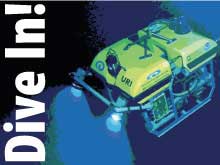Education Lesson Plans
The 2004 Gulf of Alaska Seamount Expedition presents a unique opportunity to engage explorers of all ages as we journey to a world that few have seen. Scientists will be exploring five large seamounts located approximately 200 miles off the Alaska coast. The seamounts are biological "islands" in the deep ocean that often feature characteristic organisms that are quite different from those found in the surrounding deeper habitats. Scientists will focus their investigations on sea floor aging and characterization, deep-sea coral genetics, and community ecology. The explorations will be conducted on board the Woods Hole Oceanographic Institution’s research vessel Atlantis and scientists will be using the manned-submersible Alvin to document their findings.
Educators and scientists working with NOAA in June 2004 developed a series of lesson plans for students in Grades 5-12 that are specifically tied to the 2004 Gulf of Alaska Seamount Expedition. These lesson plans focus on cutting-edge ocean exploration and research, using state-of-the-art technology. Lessons focus on deep-sea coral communities associated with seamounts, the influence of microorganisms on geochemical processes, and the morphology and ecological function in habitat-forming deep-sea corals.
The lesson plans are grouped into the following categories:
Grades 5-6Grades 7-8
Grades 9-12
Each grade-level grouping includes an activity that focuses on the exploration and research being conducted as part of the 2004 Gulf of Alaska Seamount Expedition. In addition to being tied to the National Science Education Standards, the hands-on, inquiry-based activities include focus questions, background information for teachers, links to interesting Internet sites, and extensions. Web logs that document the latest discoveries and complement the lesson plans, complete with compelling images and video, will be sent back each day from sea. Additional lesson plans from previous expeditions to Alaska seamounts can be found at http://oceanexplorer.noaa.gov. Teachers are encouraged to use the daily logs from the 2004 Gulf of Alaska Seamount Expedition, which are posted on this site, to supplement the lesson plans.
Read a description of each lesson plan and/or download them to your computer. All of the lesson plans are available in pdf format and may be viewed and printed with the free Adobe Acrobat Reader ![]() . To download a lesson plan, click on its title from the listing below.
. To download a lesson plan, click on its title from the listing below.
Grades 5-6
Forests of the Deep (4 pages, 232k)
Focus: Deep-sea coral communities associated with seamounts (Life Science)
In this activity, students will be able to explain at least three ways in which seamounts are important to biological communities, infer at least three ways in which deep-sea corals are important to seamount ecosystems, and explain why many scientists are concerned about the future of seamount ecosystems.Grades 7-8
Architects of Seamount Ecosystems (6 pages, 300k)
Focus: Morphology and ecological function in habitat-forming deep-sea corals (Life Science)
In this activity, students will be able to describe at least three ways in which habitat-forming deep-sea corals benefit other species in deep-sea ecosystems, explain at least three ways in which the physical form of habitat-forming deep-sea corals contributes to their ecological function, and explain how habitat-forming deep-sea corals and their associated ecosystems maybe important to humans. Students will also be able to describe and discuss conservation issues related to habitat-forming deep-sea corals.
Grades 9-12
In this activity, students will describe how microbial metabolism may affect the dissolution of igneous rocks, define and explain the function of siderophores, describe at least two ways in which bacteria may utilize iron, and explain why iron availability may limit biological activity even though it is extremely abundant in nature.
For More Information
Contact Paula Keener-Chavis, national education coordinator for the NOAA Office of Ocean Exploration, for more information.
Other lesson plans developed for this Web site are available in the Education Section.

























